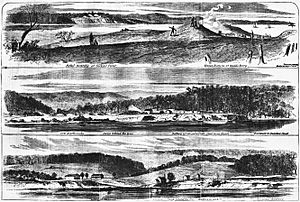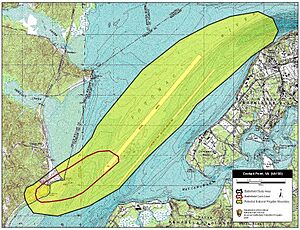Battle of Cockpit Point facts for kids
Quick facts for kids Battle of Cockpit Point |
|||||||
|---|---|---|---|---|---|---|---|
| Part of the American Civil War | |||||||
 The rebel batteries on the Potomac now in possession of our troops. A sketch from 1862 by Harper's Weekly showing the aftermath of the engagement at Cockpit Point. |
|||||||
|
|||||||
| Belligerents | |||||||
| Commanders and leaders | |||||||
| Strength | |||||||
| 2 gunboats | 50 men 4 batteries |
||||||
The Battle of Cockpit Point was a small but important fight during the American Civil War. It happened on January 3, 1862, in Prince William County, Virginia. This battle was part of a larger effort to block the Potomac River. It is also sometimes called the Battle of Freestone Point or the Battle of Shipping Point.
Contents
Why the Battle Happened
Confederate Goals on the Potomac
After winning the First Battle of Bull Run, the Confederate States Army (CSA) set up defenses. They created a strong line from Centreville to the Potomac River. The Confederates wanted to stop Union ships from using the river. This would protect important areas like Manassas Junction and Fredericksburg. It would also cut off Washington, the Union capital, from supplies by river.
Building River Defenses
To block the river, the Confederates built many gun positions. These were called batteries. They placed them along the Potomac's banks. By late 1861, they had 37 large guns ready.
Key Battery Locations
- Evansport: This area, now part of Quantico, had two batteries.
- Chopawamsic Creek: A battery was placed at the mouth of this creek.
- Shipping Point: This is now Hospital Point in Quantico.
- Freestone Point: This battery had four guns. It is now inside Leesylvania State Park.
- Cockpit Point: This was a very strong position. It had six guns, including one heavy gun. It was on a 75-foot-high cliff called Possum Nose. It also had a place to store gunpowder and trenches for soldiers.
Early Skirmishes and the Main Battle
Union Ships Test Defenses
Union ships often tried to test the Confederate defenses. On September 25, 1861, two Union ships, the USS Jacob Bell and the Seminole, shelled the Freestone Point batteries.
On January 1, 1862, two more Union ships, the Anacostia and the Yankee, attacked Cockpit Point. Neither side gained a clear win. The Yankee was slightly damaged in this fight.
The Battle of January 3, 1862
The main battle happened on January 3, 1862. Union ships again approached Cockpit Point. The fighting was intense, but neither side managed to defeat the other. The battle ended without a clear winner, meaning it was "inconclusive."
After the Battle
Confederate Withdrawal
On March 9, 1862, Union ships returned to Cockpit Point. A landing party from the Anacostia and Yankee went ashore. They found that the Confederates had left their batteries at Cockpit Point and Evansport. The Confederates had also blown up one of their ships, the CSS Page.
The Confederates decided to move their forces closer to Richmond. They had successfully blocked the Potomac River for almost five months. This made it hard for the Union to use the river.
Legacy of Cockpit Point
Prince William County is working to create the Cockpit Point Battlefield Heritage Park. This park will help protect the history of the area. It will cover 113 acres, including the old gun battery site along the Potomac River. The park will show where the cannons were placed.



